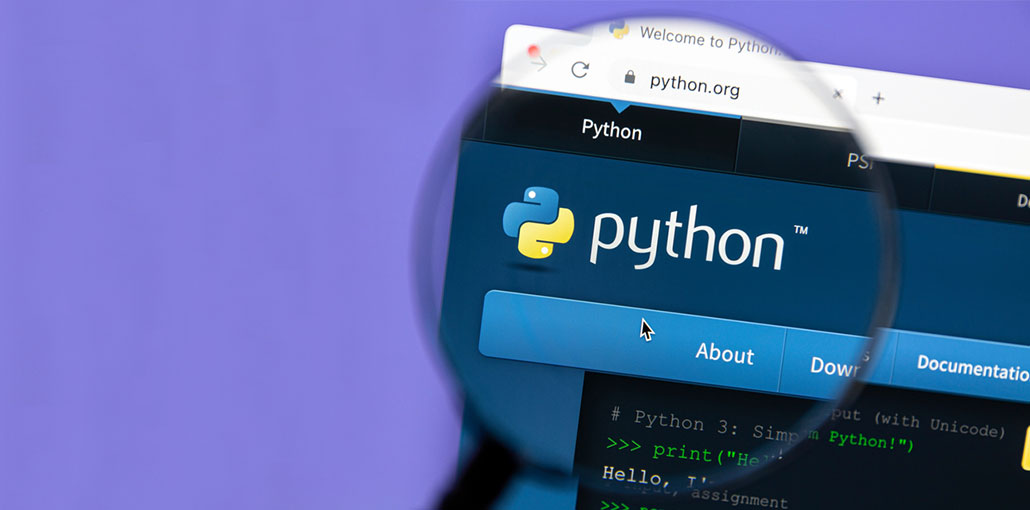Every business will eventually need to implement programming to some extent; there’s no avoiding it. In the digital age, every successful business is using technology to improve its business functions. The chances are that keeping up with the competition will require your business to integrate specially programmed software into its operations. This is done either by hiring a service, employing a development team, or both.
Python is, by far, one of the most popular programming languages used by businesses today. The ease of use and various specializations of the Python language makes it a powerful tool for automating business processes, managing server back-ends, speeding up tasks, and various other applications.
This post will give you a brief overview of Python as a programming language, its main applications, and how you can start learning it.
What Is Python?
Python is a simple and flexible programming language with many applications, making it one of the most popular languages in the world. More specifically, Python is a high-level, interpreted, object-oriented programming language.
While this definition may sound complicated, it simply means that it’s an easy read, easily written programming language that’s simple to deploy and conforms to standard programming practice. These qualities are what make Python so widely used. It’s also one of the most popular beginner languages to learn for many of the same reasons.
Also read: Julia vs Python: Which Programming Language is Better?
The Main Applications Of Python
Although it’s technically possible to do nearly anything with any programming language, each language tends to do better in some applications than others. Python is quite versatile among programming languages and doesn’t fall into any one defined niche. That said, there are some applications where the language excels. Here are some of Python’s most prominent applications.
1. Machine Learning
Data science and machine learning are among the top programming and technology topics circulating the internet in recent years. In the world of machine learning, Python is the dominating language, with roughly 60% of machine learning developers opting to use it over other languages.
The leading reason for this seems to be that the language’s simple syntax takes additional complications out of an already complicated topic. You’d have trouble finding a developer who’d prefer to write complicated algorithms with complex syntax if given an alternative choice.
Companies like cnvrg.io use Python to dive into further machine learning topics like deep learning, natural language processing, and sentiment analysis. They state that these things can help businesses monitor customer feedback, brand perception, social media, and other important consumer-related operations.
2. Web Development
This is almost certain to come up in any lengthy discussion concerning Python’s main uses. Python is undoubtedly one of the most used programming languages on the internet, alongside other languages like JavaScript and PHP. Web development is crucial for any business, and this is where Python will most likely offer your business the most immediate benefits.
There are multiple Python libraries and frameworks that can be useful on the web. Examples include Flask, Django, Pyramid, and Bottle. These frameworks all support the development of web and server-related systems. They’re also capable of integration with other languages and frameworks in web development like React.js.
3. Data Visualization
As the name implies, data visualization refers to the collection, organization, and displaying of data in a visual and graphical representation. Python has several libraries that lend themselves to data visualization, like the Matplotlib library.
Businesses that amass data, as most do, can greatly benefit from making use of data visualization. By formatting datasets into graphical representations, a business can better assess its own patterns, consumer patterns, and trends and make overall more informed decisions.
4. Other Applications
The three applications listed above are some of Python’s most common uses. However, it can be used for a whole other range of things. You can use the language to code simple automation scripts that run in the background on a computer, like automatically moving downloaded images to a specified folder. It can also create full desktop applications. You can even use the Pygame library to make games in Python.
Getting Started With Python
Now, starting with Python could mean several things from a business perspective. It would be beneficial for an entrepreneur running a small business to understand at least the fundamentals. This can allow you to either work on your systems or have a better grasp of the possibilities when employing someone to manage your Python programs.
On the other hand, you may be an aspiring developer looking to land a job because Python developers are among the top coding jobs. Either way, these are the basic steps that any new Python programmer will take:
Learn The Basics
The first step to getting started with Python programming is to understand the fundamentals of object-oriented programming. This can be achieved with just about any programming language—once you know one programming language, it’s not too difficult to learn another. On that same note, you should be able to learn Python relatively easily if you’re migrating from another programming language.
The basics involve object-oriented programming concepts such as data types, variables, strings, flow control, conditional statements, lists, sets, arrays, dictionaries, file handling, and input/output handling. These will all start making sense as you learn to program. There are many free and paid Python tutorials and courses to help you.
Expand Your Knowledge
At this stage, it’s beneficial to start looking at the application-specific skills you’ll need. For example, data science and machine learning generally require a working understanding of linear algebra and other forms of math.
You may also want to look into more advanced programming concepts such as data structures and algorithm theory. These are essential if you want to start writing fast, clean, organized code.
Learn A Relevant Framework Or Library
Building on the previous step, it’s now time to learn an additional Python framework or library that fits your needs. For example, you’d most likely learn the Django framework if you intend to use Python for web development. For data sciences and machine learning, you may need to learn how to use the Panda or NumPy libraries.
Once again, many online resources can help you along the way. Remember that you may need to compare various frameworks or libraries before deciding which to learn first. It may depend on what you want to do, how fast you want to do it, or simply what interests you most.
Also read: Top 15 Ways to Make Money with Machine Learning
Build Practice Projects
There’s a stage in learning that programmers often refer to as ‘tutorial purgatory.’ This refers to when programmers keep watching courses and tutorials in an attempt to expand their knowledge instead of putting their knowledge into practice. While it’s important to keep learning, most tutorials eventually end up giving you the same overall grasp of the content.
Some may better suit your learning style than others or offer a small piece of advice that another doesn’t. But you’ll get better at coding faster if you start building practice projects.
After watching one or two tutorials, start building something that interests you. You may start with a few small ones before moving on to bigger projects. Learning by practicing will give you better exposure to the code and common challenges faced when coding.
After you’ve familiarized yourself with Python programming through these practice projects, you should be ready to start tackling the relevant business problems. If you’re learning programming to land a job, your projects can be added to your portfolio and give you a higher chance of landing the job you want.
Conclusion
Python is one of the most widely used programming languages in the world. Its simplicity and versatility make it a top pick for developers across various industries—web development and machine learning being two of the most common. Being as versatile as it is, there’s no doubt that Python development can help your business grow in various ways, whether you outsource developers, learn to do it yourself, or have an in-house team.










Leave a comment